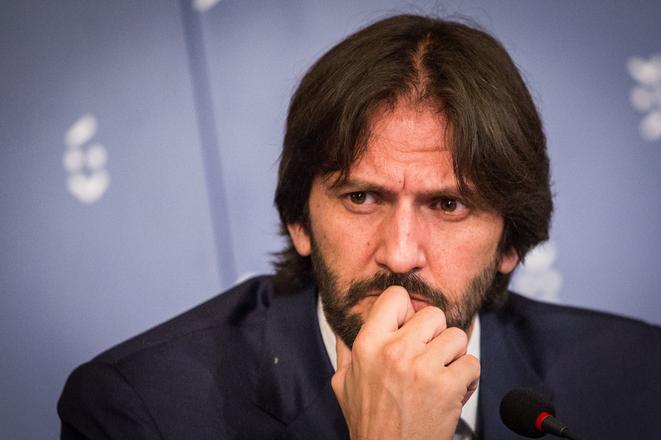A person very close to Interior Minister Robert Kaliňák received – under the Smer-led government – a subsidy for a project to which Kaliňák is directly connected.
The person is lawyer Marek Turčan, a neighbour of Kaliňák, and also his friend and business partner. Turčan also does business with developer Ladislav Bašternák who is suspected of tax frauds worth millions and which police have refused to investigate.
Ministerial company
A subsidy of €92,000 was given by the state in 2013 to the private company Erupsi in order to help Montenegro with building its state border security.
The partner and only legal representative of this company is Turčan. The second partner is Peter Šimko, who at the time worked for Kaliňák as project manager of the technical protection of the border with Ukraine.
The company Erupsi was established in 2011. It resided, according to the trade register, on Miletičova Street in Bratislava where Kaliňák then had the company FoRest together with ex-minister Ján Počiatek.
In February 2013, Erupsi moved to Karadžičova Street where Turčan’s law agency also resides. The B. A Haus company, featuring Turčan together with shareholders Kaliňák and Počiatek, also has its residence there.
With Kaliňák's full trust
The project of helping build Montenegrin borders was implemented via the Agency for International Development Cooperation at the Foreign Ministry. Its partner organisation was the Montenegrin Interior Ministry.
The Slovak Interior Ministry, led by Kaliňák, was not officially engaged. However, the statement of the Slovak representation office in Podgorica states that the project had the full trust of the Slovak Interior Ministry.
“The idea was born in the course of negotiations of Interior Minister R. Kaliňák and Montenegro’s minister I. Brajovič during the former’s official visit to Montenegro in June 2012,” the document reads.
Kaliňák did not say whether he considers it a problem that the project he dealt with as a minister was finalised by the private firm of his friend Turčan.
Highly esteemed experience
Initially, the Interior Ministry refused to respond to Sme concerning the project. Finally, it sent a one-sentence statement: “Neither the Interior Ministry, nor the Interior Minister, had any influence on its preparation or implementation.”
Turčan’s company Erupsi claims, too, it did not cooperate with the ministry in any way. When presenting its aim back in 2013, however, it cited experience which Slovakia got during the building of border protection with Ukraine after joining the EU. This was during Kaliňák's term.
In the supplement accompanying the application for the grant – which Sme has at its disposal – Erupsi named building the protection of the Slovak border security with Ukraine directly among its references. That border was included among projects “realised by the applicant, as well as individual members of the consultancy team”.
Projects in the shadow of the ministry
Another recommendation of the company stated in the application is the cooperation in building the Integrated System of the Slovak Republic, worth ten million euros in total. This, too, falls under the remit of the Interior Ministry. Turčan’s company insists that the application for a subsidy for the Montenegro operation was made in a standard way.
“After our application was evaluated, we received the decision of it being approved,” Karol Achberger, who communicates for Erupsi, told Sme.
In the application, they originally asked for a subsidy of €100,000. The development cooperation agency approved €92,000, and the total subsidy paid was €75,600.
The current head of the agency Zuzana Letková could not say anything more about the circumstances of evaluating the application, as she joined the agency only later.
With Lajčák’s approval
Letková added that normally a committee evaluates various projects, which then sends them for approval to the foreign minister. Under the previous government of Robert Fico, it was Foreign Minister Miroslav Lajčák (nominee of Smer) who approved it.
The Montenegro project was completed in 2013 and 2014, and it involved drafting a document concerning technically securing land and water border areas, as well as border crossings. Part of the duties included physical inspections on-site.
Ten consultants participated in the project, according to Achberger, who over the course of fourteen months worked several hundred man-days. He did not specify, though, from where the company got the consultants.
The result is a document which should serve for Montenegro – as a potential candidate for EU entry – during decisions on further steps in this field.
They also dealt with floods
Already in 2011 and 2012, Erupsi explored the issue of flood risks in Montenegro, which also falls under the Interior Ministry. It received a contribution from the Foreign Ministry in the same way, of €200,000.
Erupsi has a simple website which states only basic information and merely mentions the border project in Montenegro among its projects. It also cites activities in Slovakia, the Czech Republic and Austria.
Kaliňák is a neighbour of Turčan in a luxury apartment house on Sklenárska Street in Bratislava. When Kaliňák explained in June his purchase of shares in the B. A. Haus company from Bašternák, he also argued against the fact that the company owns two neighbouring apartments, and that he may want to gain control over them.
Another dubious grant for Kalinak’s friend
The project of border protection was not the only dubious undertaking that involved the Erupsi company in Montenegro.
The Sme daily reported on September 30 that Slovakia also paid €200,000 through the SlovakAid agency for the project of flood protection. Erupsi lists the project among the references submitted for the project of border protection. It dates back to 2011, when Smer was not in the government in Slovakia.
“The FloodDefence.MR project was realised also through the project scheme of official development help of the Slovak Republic,” Erupsi’s representative Karol Achberger told Sme.
SlovakAid, however, claims they have no such project listed in their documentation in 2011, Sme reported.


 Interior Minister Robert Kaliňák (source: SITA)
Interior Minister Robert Kaliňák (source: SITA)